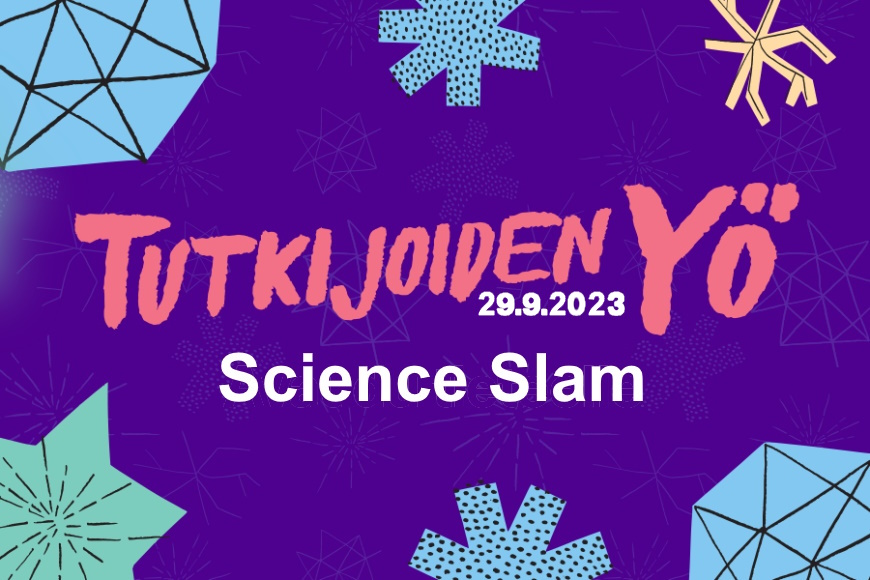Science Slam -kisassa tutkijat irrottelevat tiedettä ja stand up -komiikkaa yhdistelevissä puheenvuoroissa. Luvassa on hauskaa tiedesuitsutusta ja riemua yli tiederajojen.Kuka on paras/hauskin/viihdyttävin? Sinä päätät.
Voittajalle on palkintona luvassa mainetta ja kunniaa sekä tavoiteltu kultainen mikrofoni.
Ovet aukeavat klo 18.30 ja Science Slam alkaa klo 19.00 The Old Irish Pubissa Hämeenkadulla.
_________________________
Come and witness yourself the ninth round of Science Slam -competition, where researchers combine science and stand up -comedy in hilarious mixture.
Brave scientists take the stage presenting their studies in completely new manner. The event will be of joy and lauhter of scientific nature.
Who ist the best / the funniest / the most entertaining? You decide. The victor will be awarded fame and glory and the prestigious golden microphone.
Doors open 18.30 and Showtime 19.00 at The Old Irish Pub in Hämeenkatu, Tampere.
Mukana kisassa ovat / The competitors are:
Liisa Häikiö,
professori, sosiaalipolitiikka / Professor, Social Policy
Yhteiskuntatieteiden tiedekunta /Faculty of Social Sciences
Common city
I look at the city, living there and its transformation from the perspective of different actors: the young, the old, the vulnerable, the powerful, communities and networks. I will take examples from studies carried out in Tampere over the years. How is the city shared and shared by us all? Or is it?
Chloe Kiernicki,
Master’s student in Sustainable Architecture
Rakennetun ympäristön tiedekunta/Faculty of Built Environment
Digital Twins for wind turbine reuse
Chloe’s research was part of a larger Re-Wind team across the United States, Republic of Ireland, and the United Kingdom. The global team is seeking reuse solutions for wind turbines that have been decommissioned at their end-of-service life. Chloe’s focus has been on using point cloud scans to create digital twin versions of blades to model their form, internal geometry, and structural properties.
Markus Laine
yliopistonlehtori, hallintotieteet / University Lecturer, Administrative Studies
Johtamisen ja talouden tiedekunta/ Faculty of Management and Business
Nordic Superblock – The Way Towards Sustainable Urban Transformation?
Introduction Finland’s ambition to be carbon neutral by 2035 places it at the forefront of decarbonization in Europe. Thus, the goal of the Nordic Superblocks is to provide a new, integrated concept for sustainable urban transformation.The core idea of the Nordic Superblock lies in shared resources, in the interest of providing maximum spaces, functions, and services with minimum cost and environmental impact. It creates a new scale to urban planning and development. Instead of just neighborhood planning and developing single plots the Nordic Superblock is mid-scale planning and development idea. Ultimately this scale makes maximum spaces, functions, and services with minimum cost and environmental impact possible. It can be just one block, or several blocks, depending on the site and purpose.
Ruchira Liyanage
Master’s student in Sustainable Architecture
Faculty of Built Environment / Rakennetun ympäristön tiedekunta
Vegetation Cover Effects on Outdoor Thermal Comfort
The global shift toward sustainable building materials and processes has led to the emergence of concepts like Eco-mimicry and Biomimicry. These approaches draw inspiration from nature to achieve ecological goals. Nature offers solutions to a wide range of contemporary challenges, and one such issue is the assessment of thermal comfort in outdoor environments, which can be quantified using modern indices like the Predicted Mean Vote (PMV) index.This research endeavors to comprehend the impact of vegetation cover on outdoor thermal comfort. Ruchira Liyanage is dedicated to studying various aspects of outdoor thermal comfort, including urban heat islands, local climate zones, building materials, and principles of Eco-mimicry rooted in the natural world. He firmly believes that taking cues from nature will consistently lead us toward more sustainable resolutions for impending issues, such as climate change, the circular economy, and the thermal comfort of buildings.
Jonathon Taylor,
Tenure track -professori, Urban Physics/ Associate Professor in Urban Physics (Tenure Track)
Faculty of Built Environment/ Rakennetun ympäristön tiedekunta
Using Science and Engineering to Design Future Cities
The way we design our cities can influence the amount of energy we consume, the amount of greenhouse gas emissions we produce, and the health of the citizens. Jonathon will be talking about how physics and engineering can be used to help us understand our urban environments, from microscopic to global scales, both now and in the future.
Anna-Kaisa Viitanen,
tutkijatohtori / Postdoctoral Research Fellow,
Rakennetun ympäristön tiedekunta / Faculty of Built Environment
Better air quality for urban dwellers
Air pollution is one of the main issues in the urban areas affecting negatively to people’s health. By understanding the sources of pollution, we can protect ourselves and our environment. Anna-Kaisa is studying air pollution in urban environments, especially indoors. There are several tangible actions that the society and the individuals may take to diminish the air pollution and to prevent the exposure. These actions will lead to more sustainable environment and promote people’s health and well-being in the cities.
Lisätietoa/More information: https://events.tuni.fi/tutkijoidenyo/


